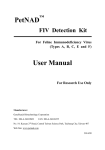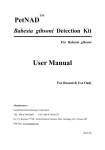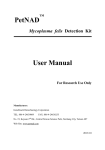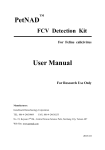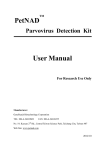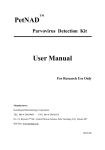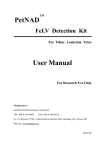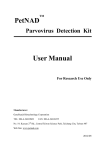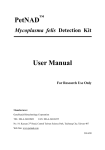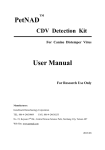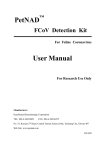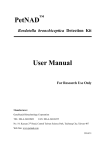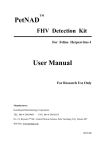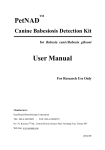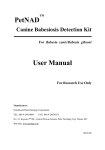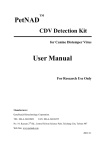Download User Manual PetNAD
Transcript
TM PetNAD FIV Detection Kit For Feline Immunodeficiency Virus (Type A, B, C, E and F) User Manual For Research Use Only Manufacturer: GeneReach Biotechnology Corporation TEL: 886-4-24639869 FAX: 886-4-24638255 No. 19, Keyuan 2nd Rd., Central Taiwan Science Park, Taichung City, Taiwan 407 Web Site: www.petnad.com 2013/03 PetNADTM FIV Detection Kit Content INTENDED USE ................................................................................ 1 SUMMARY AND EXPLANATION................................................. 1 PRINCIPLES OF THE PROCEDURE ............................................ 2 PRODUCT DESCRIPTION.............................................................. 3 A. Materials Provided .................................................................................3 B. Materials and Equipments Required, but Not Provided .........................3 C. Storage and Stability ..............................................................................4 D. Sample Type...........................................................................................4 PRECAUTIONS ................................................................................. 5 LIMITATIONS .................................................................................. 6 PROCEDURE ..................................................................................... 7 A. PetNADTM FIV Detection Kit Quick Guide ..........................................7 B. Procedure ...............................................................................................8 DATA INTERPRETATION ........................................................... 10 ANALYTICAL SENSITIVITY ...................................................... 10 TROUBLESHOOTING ................................................................... 11 REFERENCE ................................................................................... 13 i PetNADTM FIV Detection Kit INTENDED USE PetNADTM FIV Detection Kit is intended for in vitro detection of FIV RNA based on insulated isothermal polymerase chain reaction (iiPCR) technology. This kit is designed specially to be used with an iiPCR-compatible instrument, POCKITTM Nucleic Acid Analyzer. The assay is intended for use by veterinarians or technicians with basic laboratory skills. This kit is intended for research use only. SUMMARY AND EXPLANATION Feline immunodeficiency virus (FIV) is a lentivirus associated with AIDS-like illness in cats (Sodora et al., 1994). Five subtypes (A to E) have been isolated based on sequence diversity in various regions (Madhu et al., 2010). The primary routes of FIV transmission are through deep bite wounds and scratches, where the infected cat’s saliva enters the other cat’s bloodstream (American Association of Feline Practitioners, 2002). FIV could also be transmitted from pregnant females to the fetus in their utero. FIV infections are not necessarily fatal. Cats could live relatively healthy life and act as FIV 1 PetNADTM FIV Detection Kit carriers for years. In initial phase or acute phase of FIV infection is often accompanied by mild symptoms such as fever, lethargy, anorexia, pyrexia and lymphadenopathy (Janet et al., 2010). PCR is one of the most commonly accepted methods that provide high sensitivity and specificity for FIV detection. However, conventional PCR assays take three to four hours, and require sophisticated thermocyclers and well-trained technicians to perform. GeneReach has developed PetNADTM FIV Detection Kit based on iiPCR technology, which significantly reduces reaction time and offers sensitivity and specificity comparables to those of conventional nested PCR (Tsai, 2012; Chang, 2012). Furthermore, this simple and easy assay could be completed rapidly in a portable POCKITTM Nucleic Acid Analyzer. PRINCIPLES OF THE PROCEDURE In iiPCR, hydrolysis probe-based chemistry is used to generate fluorescent signal during amplification of target RNA. The primers and probe target gag gene and do not cross-react with nucleic acid from host and other feline pathogens. 2 PetNADTM FIV Detection Kit PRODUCT DESCRIPTION A. Materials Provided (24 tests/kit) Component Contents or Purpose Premix Pack Amount FIV Premix (lyophilized 24 bags (1 FIV Premix pellet) containing dNTPs, vial and desiccating primers, probe, and enzyme agent/bag) for amplification. Premix Buffer A Desiccating agent pack. Reaction buffer to re-dissolve 2 vials (1.3 ml/vial) the lyophilized pellet. P(+) Standard Dried plasmid containing FIV 1 vial partial sequence. Standard Buffer Reaction buffer to re-dissolve 1 vial (110 μl/vial) P(+) Standard. R-tube 1 bag (24 pieces/bag) Cap 1 bag (24 pieces/bag) User Manual 1 copy B. Materials and Equipments Required, but Not Provided 1) PetNADTM Nucleic Acid Co-prep Kit 2) POCKITTM Nucleic Acid Analyzer: PetNADTM-compatible instrument. 3) cubeeTM Mini-Centrifuge (cubee) 4) Micropipette and tips 3 PetNADTM FIV Detection Kit C. Storage and Stability 1) The kit should be stored at 4°C and is stable until the expiration date which is stated on the label. 2) Store Premix vials in sealed Premix Pack to avoid hydration of lyophilized components. 3) Reconstituted P (+) Standard is stable for 6 months at 4°C. Aliquot reconstituted P (+) Standard to avoid degradation of nucleic acid. D. Sample Type Nucleic acid extracted from whole blood. 4 PetNADTM FIV Detection Kit PRECAUTIONS A. Do not open R-tube(s) after reaction to prevent any carryover contamination. B. Perform extraction and amplification in two independent spaces to minimize contamination. C. Do not reuse R-tube and Premix. D. Include the P(+) Standard to: 1) Ensure POCKITTM Nucleic Acid Analyzer is working normally. 2) E. Ensure detection kit performance after storage. To get optimal fluorescence detection. 1) Wear powder-free gloves to Label area handle R-tubes. 2) Do not label in the detection area of R-tube. 5 Detection area PetNADTM FIV Detection Kit LIMITATIONS A. The test should be used only for testing nucleic acid extracted from animal specimen. Do not add specimen (i.e. whole blood) directly into Premix. B. PetNADTM Nucleic Acid Co-prep Kit is recommended for nucleic acid extraction. C. Any deviation from recommended procedure may not achieve the optimal results and should be validated by the users. D. It is strongly recommended to use freshly prepared nucleic acid (within 1 hour after extraction) to achieve optimal results with PetNADTM FIV Detection Kit. 6 PetNADTM FIV Detection Kit PROCEDURE A. PetNADTM FIV Detection Kit Quick Guide 7 PetNADTM FIV Detection Kit B. Procedure Note: Before using for the first time, add 100 μl Standard Buffer to P(+) Standard. Store reconstituted P(+) Standard at 4°C. 1) Label R-tube(s) in the label area. 2) Prepare one Premix for each sample. (Premix tube is in Premix Pack. Each Premix Pack contains one Premix.) Note: If the pellet is not found at the bottom of the tube, spin tube briefly to bring it down. 3) Add 50 μl Premix Buffer A to each Premix tube. 4) Add 5 μl nucleic acid extract or P(+) Standard to each Premix tube. Mix by pipetting up and down. 5) Transfer 50 μl Premix/sample mixture into R-tube. 6) Seal top of each R-tube with a cap. Make sure R-tube is capped tightly. 7) Place R-tube into the holder of POCKITTM. 8) Spin tube briefly in cubeeTM to make sure all solution is collected at the bottom of R-tube. Note: Start reaction within 1 hour to prevent nucleic acid degradation. Note: Make sure there are no bubbles in the tube. 9) POCKITTM reaction: Note: Please see the user manual of POCKITTM for details. a) Turn on POCKITTM, which should complete 8 PetNADTM FIV Detection Kit self-testing within 5 minutes. b) Select ″520 nm″. c) When ″System READY″ is displayed, place the holder with R-tube(s) into the reaction chamber. d) Tap cap of each R-tube to make sure the tube is positioned properly. 10) Close lid and press ″Run″ to start reaction program. 11) Test results are shown on the monitor after reaction is completed. 9 PetNADTM FIV Detection Kit DATA INTERPRETATION * One example of results shown on the monitor. 520nm Interpretation FIV Positive FIV Negative Repeat reaction with freshly prepared nucleic acid. ANYLYTICAL SENSITIVITY The detection limit of PetNADTM FIV Detection Kit is about 10 copies/ reaction. 10 PetNADTM FIV Detection Kit TROUBLESHOOTING Problems Possible causes Solutions False Positive 1) Reuse of micro- Micro-centrifuge tubes, tips, centrifuge tubes, R-tubes and Premix are for tips, R-tubes and single-use only. Reusing these Premix. accessories would cause crosscontamination. Used micro-centrifuge tubes, tips, R-tubes and Premix should be collected and discarded according to local regulation. Do not place the waste close to the working area to prevent cross-contamination. Disassemble and clean up 2) Contaminated micropipette micropipette. Use aerosol-free tips. Consult with a GeneReach 3) Contaminated reagent technical support representative or local distributor. Consult with a GeneReach 4) Contaminated working area technical support representative on how to clean up working. 11 PetNADTM FIV Detection Kit Problems Possible causes Solutions False 1) Nucleic acid Consult manual of nucleic acid Negative extraction failed. extraction kit. Check sample storage condition. 2) Bad nucleic acid Please refer to Troubleshooting quality or nucleic acid concentration section of PetNADTM Nucleic Acid too high Co-prep Kit. If a spectrophotometer is available, check OD 260/280 ratio. This ratio should be between 1.4 and 2.0. Do not overload nucleic acid. 3) PCR inhibition Spike nucleic acid sample into P(+) Standard reaction for a parallel PCR reaction. Negative results indicate the presence of inhibitors in the nucleic acid. In that case, prepare another nucleic acid extract. Heavy Consult with a GeneReach 1) Leakage or spill of contamination reaction from technical support representative or of amplicons R-tube into local distributor. in reaction reaction chamber chamber of of POCKITTM. POCKITTM. 12 PetNADTM FIV Detection Kit REFERENCE 1. 2. 3. 4. 5. American Association of Feline Practitioners. (2002). "Feline Immunodeficiency Virus". Cornell Feline Health Center. Cornell University, College of Veterinary Medicine. Retrieved 2008-11-12. Chang, H.F.G., Tsai, Y.L., Tsai, C.F., Lin, C.K., Lee, P.Y., Teng, P.H., Su, C. and Jeng, C.C., (2012). A thermally baffled device for highly stabilized convective PCR. Biotechnology Journal 7(5): 662-666, doi: 10.1002/ biot.201100453 Janet, Y., Sanou, M., Abbott, J. and Coleman, J. (2010). Feline immunodeficiency virus model for designing HIV/AIDS vaccines. Current HIV Research 8: 14–25 Sodora, D.L., Shpaer, E.G., Kitchell, B.E., Dow, S.W., Hoover, E.A. and Mullins, J.I., (1994). Identification of three feline immunodeficiency virus (FIV) env gene subtypes and comparison of the FIV and human immunodeficiency virus type 1 evolutionary patterns. J. Virol. April 1994 vol. 68 no. 4 2230-2238. Tsai Y.L., Wang H.T.T., Chang H.F. G., Tsai C.F., Lin C.K., Teng P.H., Su C. and Jeng C.C., (2012). Development of TaqMan probe-based insulated isothermal PCR (iiPCR) for sensitive and specific on-site pathogen detection. PLoS ONE 7(9): e45278. doi:10.1371/journal.pone.0045278. 13















